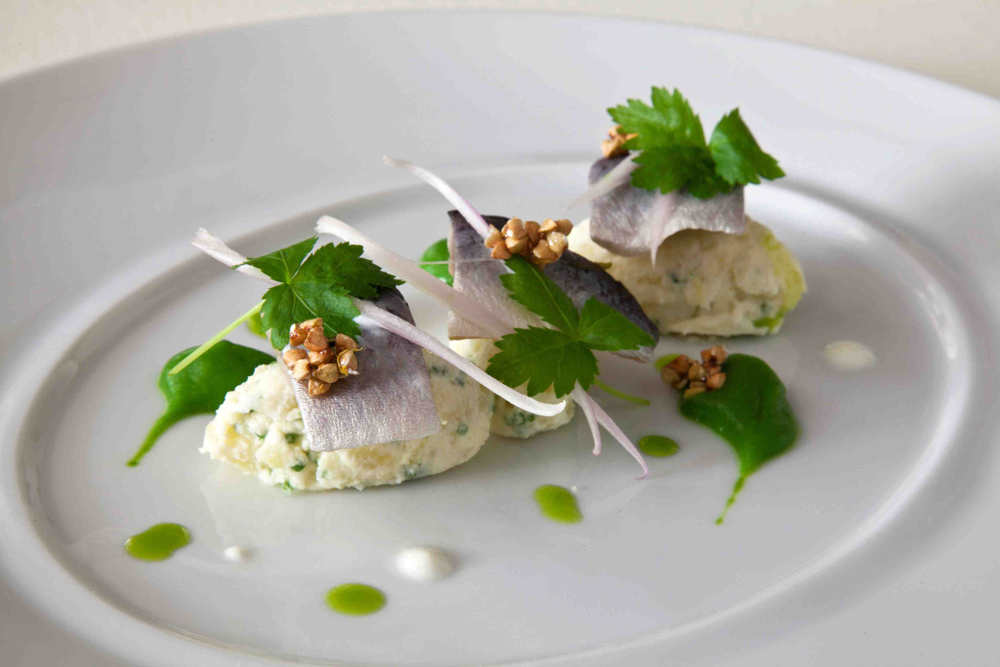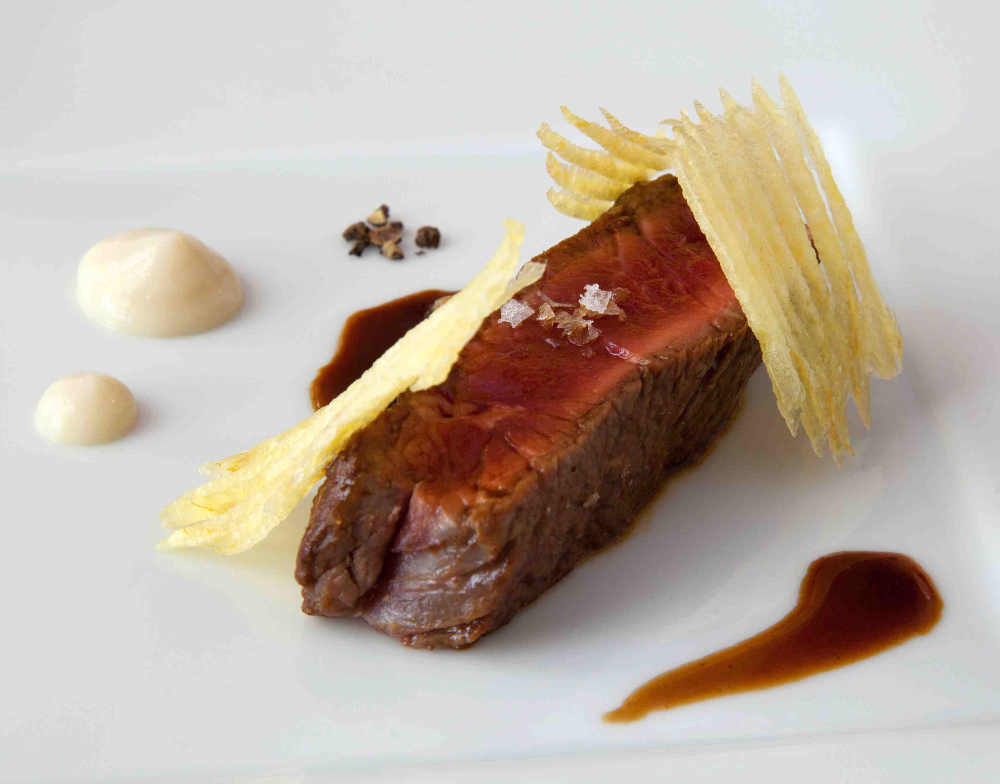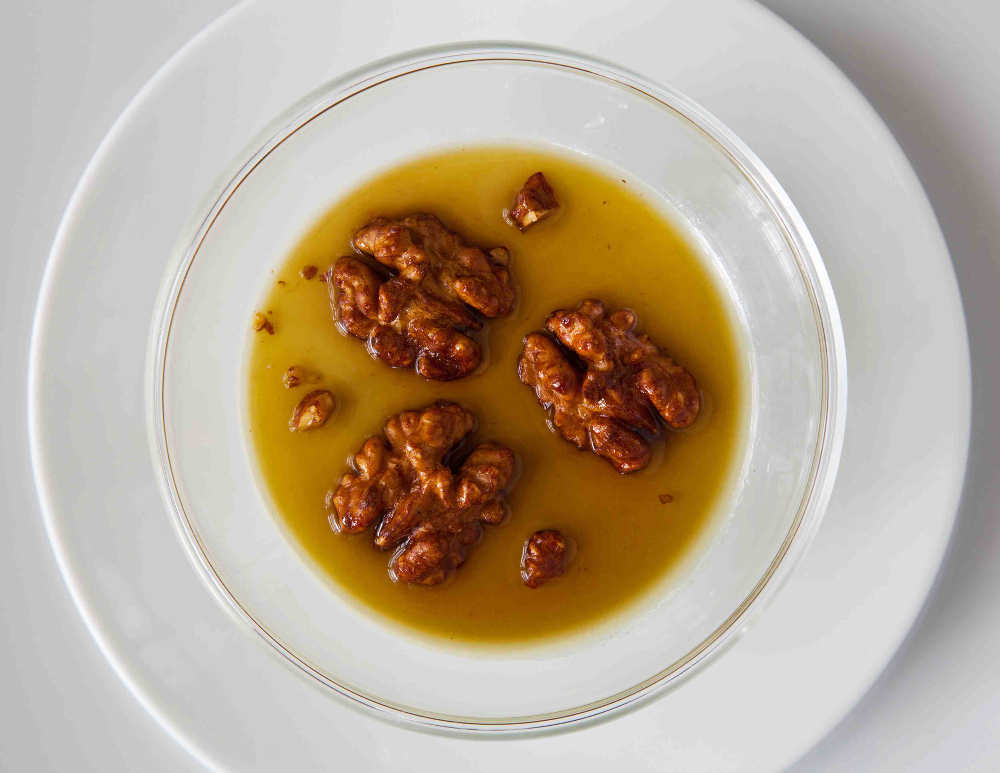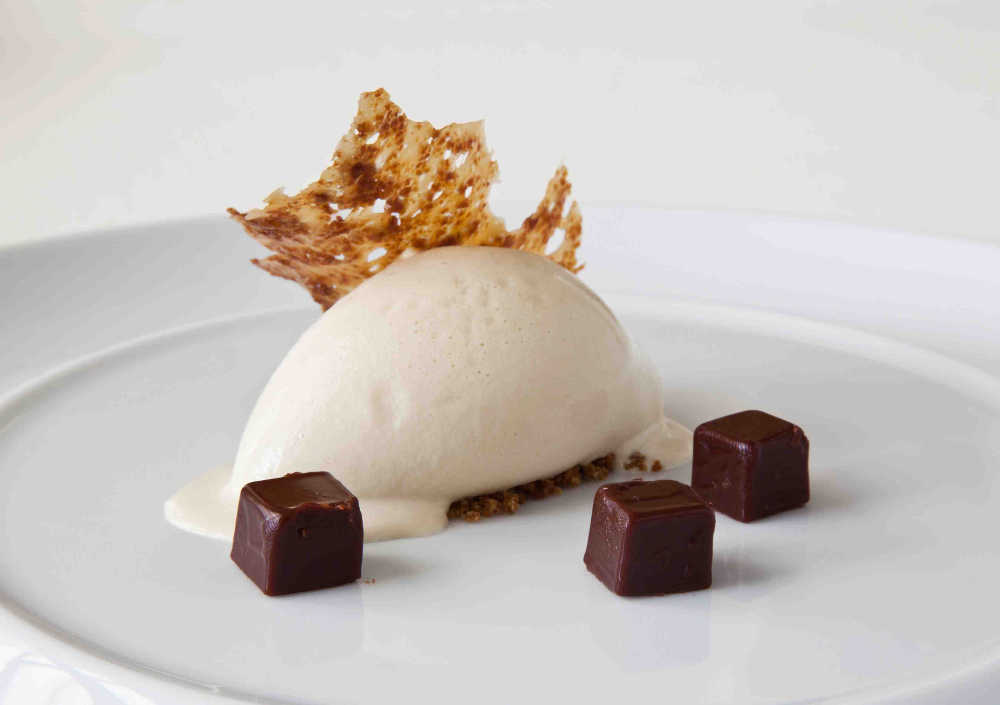Georgina Campbell's Cookery Feature - Winning Ways
A Hymn to Rural Ireland - Special Dishes Created to Showcase the 2016 Irish Food Writers’ Guild Awards
Georgina Campbell
A hymn to rural Ireland - that just about sums up the Irish Food Writers’ Guild Food Awards 2016, which are dominated this year by dedicated producers in the midlands and the stunningly good food and drink that they create. Now in their 22nd year of celebrating indigenous food, the Awards were announced at a showcase lunch at Dublin’s Restaurant Patrick Guilbaud on 2nd March.
The 2016 food product winners are Sharon and Gordon Greene’s Wild Irish Foragers & Preservers, Co Offaly, for their full range of products; Kirsti O’Kelly’s Silver Darlings, Co Limerick, for their pickled herrings; and Ralph Haslam’s Mossfield Organic Farm, Co Offaly for their organic milk.
In addition, Cuilan Loughnane’s White Gypsy Brewery, Co Tipperary, received the Irish Drink Award for their Russian Imperial Stout, while Joe Fitzmaurice of Riot Rye Bakehouse and Bread School, Co Tipperary, was presented with a Special Contribution to Irish Food Award, and this year’s Environmental Award went to Rod and Julie Calder-Potts’s Highbank Organic Orchards, Co Kilkenny.
Commenting at the Awards, Guild chairperson Aoife Carrigy said, “As a nation, our focus should be on the abundance of wonderful produce available throughout Ireland that is being made available to consumers by passionate producers who take a sustainable approach to food and food innovation, whether by re-embracing traditional approaches to age-old food sources such as milk, apples or wild berries, or by applying a modern perspective to traditional foods such as Irish fish, stout or bread. What’s really interesting about this year’s winners is that they are representative of the new energy that is emerging from the midlands for food and drink. All six have been selected for the high standard and impeccable quality of their produce, together with their dedication and commitment to Irish food. As an organisation that is devoted to being a voice for better eating, we have been shining a spotlight on the best of the best for over 20 years and this year it’s the turn of the midlands to shine.”
The Guild’s Award, which are supported by Bord Bia, are uniquely ethical in that no company or individual can enter themselves - Guild members nominate products, businesses or people they believe are worthy of an award - and all products nominated must not only be produced in Ireland (and by a producer who has been trading for at least three years) but the main ingredient must be Irish grown or produced. Products are bought and paid for anonymously by members and a formal tasting meeting takes place where members vote, using proportional representation.
Another unusual aspect of the IFWG Awards is that there are no product categories, so the range of winning products and their county of origin can vary enormously from year to year - hence County Cork sweeping the board in 2014 (with, as it happens, another strong showing in 2015), and the totally different mainly midlands representation this year.
Although it is in no way part of the criteria, the products and people nominated tend to present a snapshot of best practice in areas that are of public concern - seen this year, for example, in the sustainable practices of all winners (three of whom are organic producers) and the focus on real bread and superb milk, excellent basic foods that illustrate perfectly the difference between the mass produced and the artisan product. The exceptional quality of the winning products and dedication of the producers will inspire and energise likeminded people throughout Ireland - and confirm the value of aiming for nothing less than the highest possible standards.
For full details on these, and all award winners back to 1994, visit: www.irishfoodwritersguild.ie/food-awards.html
The Awards lunch was devised by Guillaume Lebrun, executive head chef at Restaurant Patrick Guilbaud, who ingeniously incorporated the winning produce into this special menu, which was paired with wines kindly provided by Liberty Wines. The recipes were edited by Guild Secretary Kristin Jensen
• Salad of Silver Darlings Irish Herring, Potato, Green Leek Purée and Toasted Buckwheat
• Grilled Irish Hereford Sirloin, Brandy Bay Oyster Cream and White Gypsy Russian Imperial Stout
• Mossfield Organic Farm Milk Pudding, Wild Irish Foragers Spring Nettle Syrup and Caramelised Walnuts
• Riot Rye Bakehouse Borodinsky Sourdough Ice Cream with Malted Chocolate Ganache and Malt Bread Tuile
 Salad of Silver Darlings Irish Herring, Potato, Green Leek Purée and Toasted Buckwheat
Salad of Silver Darlings Irish Herring, Potato, Green Leek Purée and Toasted Buckwheat
Serves 4
100g buckwheat groats
200g baby potatoes
200g natural yogurt, plus extra to garnish
chopped fresh chives
freshly squeezed lemon juice, to taste
1 shallot, finely sliced
200g Silver Darlings Irish Herring with Fennel and Tarragon
fresh flat-leaf parsley leaves, to garnish
For the green leek purée:
knob of butter
2 leeks, green part only, finely sliced
salt and freshly ground black pepper
Preheat the oven to 160°C. Scatter the buckwheat on a baking tray and toast in the oven for 5 minutes.
To make the green leek purée, melt the butter in a small pan and sweat the leeks. Season with salt and pepper, then blend in a liquidiser until smooth. Chill in the fridge until required.
Boil the baby potatoes until they are cooked through and tender. Drain well and return briefly to the pan to dry them out, then transfer to a bowl and gently crush them. Fold in the yogurt, some chopped chives and a squeeze of lemon juice, but be careful not to overwork the potato salad.
To serve, arrange three small quenelles of the potato salad on a cold plate and add dots of the leek purée and yogurt. Place a sliver of shallot on top of each quenelle, then add a piece of herring. Garnish with a parsley leaf and the toasted buckwheat.
Recipe created for the Irish Food Writers’ Guild Food Awards 2016 by executive chef Guillaume Lebrun of Restaurant Patrick Guilbaud, Upper Merrion Street, Dublin 2
 Grilled Irish Hereford Sirloin, Brandy Bay Oyster Cream and White Gypsy Russian Imperial Stout
Grilled Irish Hereford Sirloin, Brandy Bay Oyster Cream and White Gypsy Russian Imperial Stout
Serves 4
4 x 150g Hereford sirloin steaks
olive oil, for cooking
salt and freshly ground black pepper
waffle-cut potato crisps, to garnish
For the Brandy Bay oyster cream:
1 Brandy Bay (or other Irish) oyster
300ml fresh cream
splash of balsamic vinegar
salt and freshly ground black pepper
For the stout sauce:
750ml White Gypsy Russian Imperial Stout
500ml beef stock
1 tsp cornflour
1 marrow bone, split (ask your butcher to do this for you)
To make the sauce, pour the stout and beef stock into a pan. Bring to the boil and reduce by two-thirds. Dissolve the cornflour in a small bowl with a little water and mix together to form a thin paste, then whisk it into the sauce a little at a time until you have achieved your desired consistency. Finely dice the marrow and stir it into the sauce. Keep warm.
To make the oyster cream, place all the ingredients in a blender and blitz until smooth.
Heat a dry, heavy-based chargrill pan or skillet over a high heat. Brush both sides of the steaks with a little oil and season generously with salt and pepper. When the pan is smoking hot, put in the steaks. Cook a 2cm-thick sirloin steak for 2 minutes per side for medium rare. Remove from the pan and let the steaks rest for at least 5 minutes.
To serve, put the steak on a warmed plate. Spoon over some of the stout sauce and pipe dollops of the oyster cream on the plate. Garnish with the waffle-cut crisps.
Recipe created for the Irish Food Writers’ Guild Food Awards 2016 by executive chef Guillaume Lebrun of Restaurant Patrick Guilbaud, Upper Merrion Street, Dublin 2
 Mossfield Organic Farm Milk Pudding, Wild Irish Foragers Spring Nettle Syrup and Caramelised Walnuts
Mossfield Organic Farm Milk Pudding, Wild Irish Foragers Spring Nettle Syrup and Caramelised Walnuts
Serves 4
For the milk pudding:
3 leaves of gelatine
250ml milk
250ml cream
20g caster sugar
For the caramelised walnuts:
100g walnuts halves
100g caster sugar
To serve:
4 tbsp Wild Irish Foragers Spring Nettle Syrup
To make the milk pudding, soak the gelatine leaves in a small bowl of cold water for 10 minutes.
Meanwhile, bring the milk, cream and sugar to the boil in a medium-sized saucepan. Immediately remove from the heat and set aside to cool for 5 minutes, then squeeze out the gelatine leaves and whisk into the hot milk to dissolve. Divide between four serving glasses and chill in the fridge for at least 4 hours or overnight.
To make the caramelised walnuts, preheat the oven to 180°C. Scatter the walnuts on a baking tray and toast in the oven for 5–7 minutes, taking care not to let them burn.
Place the sugar in a saucepan over a low heat and leave to slowly caramelise without stirring. When the sugar reaches a medium to dark brown caramel, add the walnuts to the pan and swirl to combine. Pour the walnuts onto a tray lined with non-sticking baking paper and leave to cool.
To serve, pour 1 tablespoon of the nettle syrup over each pudding so that it forms a thin layer on top, then decorate with caramelised walnuts.
Recipe created for the Irish Food Writers’ Guild Food Awards 2016 by executive chef Guillaume Lebrun of Restaurant Patrick Guilbaud, Upper Merrion Street, Dublin 2
 Riot Rye Bakehouse Borodinsky Sourdough Ice Cream with Malted Chocolate Ganache and Malt Bread Tuile
Riot Rye Bakehouse Borodinsky Sourdough Ice Cream with Malted Chocolate Ganache and Malt Bread Tuile
Serves 4–6
For the ice cream:
12 egg yolks
80g caster sugar
500ml milk
500ml cream
1 loaf of Riot Rye Borodinsky sourdough bread, torn into pieces
5g fresh yeast
For the malted chocolate ganache:
265g dark chocolate, chopped
265g milk chocolate, chopped
250ml cream
150g honey
20g Horlicks malted milk powder
150g butter, cubed
For the malt bread tuile:
200g malt bread
30g caster sugar
30ml milk
40g butter
10g plain flour
To make the ice cream, whisk the egg yolks and sugar in a large heatproof bowl until well combined. Bring the milk and cream to the boil in a medium-sized saucepan. When the milk comes to a boil, slowly pour it into the egg mixture, whisking all the time. Pour the custard back into the pan and reduce the heat to low. Whisk until the custard thickens and coats the back of a wooden spoon.
Remove from the heat and stir in the sourdough pieces and yeast. Transfer to a bowl, cover with cling film and leave to infuse overnight in the fridge.
The next day, pass the custard through a fine-mesh sieve into a clean container. Churn in an ice cream machine and freeze.
To make the ganache, put the chopped chocolate in a medium-sized heatproof bowl. Heat the cream, honey and Horlicks in a saucepan over a medium heat until it comes to the boil. Pour the hot cream over the chocolate and whisk until it is completely melted. Whisk in the butter until it has melted and the ganache is smooth. Pour into a container and chill in the fridge for at least 4 hours, until firm.
To make the tuile biscuits, preheat the oven to 180°C. Line a baking tray with non-stick baking paper.
Place the bread in a food processor and whizz into crumbs. Place the butter, sugar and milk in a medium-sized saucepan and bring to the boil. Slowly add the flour and breadcrumbs. Remove from the heat and allow to cool slightly, then place tablespoonfuls on the lined tray, spaced well apart, and spread out the dough slightly. Bake for 5 minutes. When the biscuits are cool enough to handle but still warm, drape them over a rolling pin to give them a nicely rounded shape. Allow to cool and set.
To serve, dice the ganache into small cubes. Place a quenelle of ice cream on a cold plate and set a few cubes of ganache alongside. Decorate with a tuile biscuit.
Recipe created for the Irish Food Writers’ Guild Food Awards 2016 by executive chef Guillaume Lebrun of Restaurant Patrick Guilbaud, Upper Merrion Street, Dublin 2





There are currently no comments
Leave a comment
Not a member? Register for your free membership now!
Or leave a comment by logging in with: